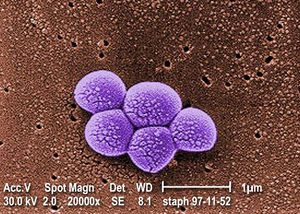Tea Tree Oil Treatment of MRSA
Introduction
Antibiotic resistance is a growing problem. As more pathogens become resistant to commonly used antibiotics, they become more difficult for medical practitioners to treat. The impotence of common antibiotics underscores the importance of determining alternative anti-microbial treatments. Studies indicate the effectiveness of tea tree oil as treatment for infections of drug-resistant bacteria, including methicillin-resistant Staphylococcus aureus, or MRSA.
Staphyloccocus aureus, also known as staph bacteria or MRSA, is a Gram-positive coccus-shaped anaerobic bacterium. MRSA is a type of staph bacteria that is resistant to beta-lactam antibiotics, such as penicillin, amoxicillin, oxacillin, and methicillin. MRSA often colonizes on the skin or nostrils of healthy individuals, and is relatively harmless at these sites. If S. aureus enters the body (e.g., wounds, cuts), it may cause infections. In such instances, the MRSA infection may range from mild (e.g., pimples)to life-threatening (e.g., infection of bloodstream, joints, or bones). MRSA is spread through contact and most commonly contracted in public settings.
Tea tree oil (TTO) is the essential oil derived through steam distillation from the Australian native plant Melaleuca alternifolia. Tea tree oil has been topically applied for centuries as a folk remedy for acne, lice, athlete's foot, and a number of other conditions. TTO has antibacterial, antifungal, antiviral, and anti-inflammatory properties in vitro.2 Although historical anecdotes endorse TTO's medicinal properties, few clinical studies have been conducted to support such evidence. Clinical studies, however few, indicate that tea tree oil can treat skin infection caused by MRSA. According to the Centers for Disease Control and Prevention (CDC), MRSA is a public health problem as it is commonly contracted in healthcare and community settings. Tea tree oil's bacteriocidal and bacteriostatic effects make this plant extract a plausible addition or supplement to a MRSA treatment plan. Tea tree oil's anti-microbial properties are attributed to its composition of a chemical class known as terpenes, specifically terpinene-4-ol.
Tea Tree Oil Composition and Chemistry
Commercially available tea tree oil (TTO) is a composition of nearly 100 chemical compounds determined by gas chromatography-mass spectrometry.1 TTO is primarily composed of a class of chemicals called terpenes. Specifically, monoterpenes, sesquiterpenes, and other terpene alcohols dominate this composition. Terpenes are volatile, aromatic hydrocarbons and are typically soluble with nonpolar solvents. 2 While research indicates that terpene alcohols are generally effective anti-microbial agents, terpinen-4-ol is the specific terpenic compound believed primarily responsible for TTO's anti-microbial activity.2
TTO composition is internationally regulated and may be commercially available in various chemotypes, including the terpinen-4-ol chemotype where terpinen-4-ol comprises between 30 to 40% of TTO's commercial composition.2 International regulation of TTO's chemical properties calls for this relatively high composition of terpinen-4-ol in commercial production due to its historical medicinal properties. Other terpenic compounds in TTO include 1,8-Cineole, terpinolene, and α-terpineol. These compounds also have medicinal properties that are less reputable than those of terpinen-4-ol.
Antimicrobial Activity
Tea tree oil exhibits broad-spectrum antimicrobial properties as reported by several studies. TTO is reported to damage MRSA's cell membrane structure, and disrupt the permeability barrier of microbial membrane structures. The following studies examined the cytoplasmic membrane damage that TTO induced in MRSA, or S. aureus.
Cox, S. D. et al (2000)4 found that exposure of S. aureus to the minimum inhibitory concentrations of TTO altered cell membrane structure. Cox et al accumulated evidence of cell membrane damage from a propidium iodide uptake assay and ion leakage measurements. Propidium iodide, a fluorescent nucleic acid staining solution, did not penetrate control S. aureus cells (i.e., not exposed to tea tree oil). Likewise, cells not exposed to TTO showed little potassium ion efflux. Cox et al found that TTO exposure resulted in propidium iodide uptake and potassium ion leakage, signs of a damaged cytoplasmic membrane. In particular, they observed that exposing cell suspensions of S. aureus to 0.25% (v/v) tea tree oil for 30 minutes increased cell permeability to propidium iodide relative to the controls. They also observed that 30 minutes of exposure to TTO resulted in up to 20% cellular loss of potassium ions.
Side Effects
Include some current research in each topic, with at least one figure showing data.
Conclusion
Though cytoplasmic membrane damage is believed to be the major bacteriocidal effect, there are still many unexplored mechanisms of TTO effects on MRSA.
Overall paper length should be 3,000 words, with at least 3 figures.
References
http://www.nhs.uk/conditions/MRSA/Pages/Introduction.aspx
http://www.ncbi.nlm.nih.gov/pubmedhealth/PMH0004520/
http://www.nlm.nih.gov/medlineplus/druginfo/natural/113.html
http://epubs.scu.edu.au/cpcg_pubs/482/
http://openi.nlm.nih.gov/detailedresult.php?img=3258290_1472-6882-11-119-1&req=4
Edited by Karen Leung, a student of Nora Sullivan in BIOL187S (Microbial Life) in The Keck Science Department of the Claremont Colleges Spring 2013.

